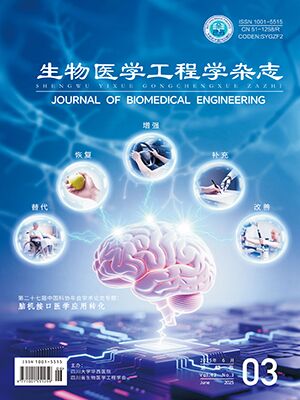| 1. |
Xu Dongcen, Tang Fengzhen, Li Yiping, et al. An analysis of deep learning models in SSVEP-based BCI: A survey. Brain Sci, 2023, 13(3): 483-483.
|
| 2. |
李奇, 张庭嘉, 宋雨, 等. 基于Hololens2的可穿戴式P300脑机接口系统设计与评估. 生物医学工程学杂志, 2023, 40(4): 709-717.
|
| 3. |
Lazcano-Herrera A G, Fuentes-Aguilar R Q, Chairez I, et al. Review on BCI virtual rehabilitation and remote technology based on EEG for assistive devices. Appl Sci, 2022, 12(23): 12253.
|
| 4. |
Gueye T, Dedkova M, Rogalewicz V, et al. Early post-stroke rehabilitation for upper limb motor function using virtual reality and exoskeleton: equally efficient in older patients. Neurol Neurochir Pol, 2020, 55(1): 91-96.
|
| 5. |
Aljalal M, Ibrahim S, Djemal R, et al. Comprehensive review on brain-controlled mobile robots and robotic arms based on electroencephalography signals. Intel Serv Robot, 2020, 13: 539-563.
|
| 6. |
Penaloza I C, Nishio S. BMI control of a third arm for multitasking. Sci Robot, 2018, 3(20): eaat1228.
|
| 7. |
Paulina K, Danielle C, O R M, et al. Robotic hand augmentation drives changes in neural body representation. Sci Robot, 2021, 6(54). DOI: 10.1126/scirobotics.abd7935.
|
| 8. |
赵思恺, 李长乐, 张宗伟, 等. 模块化可重构外肢体机器人. 仪器仪表学报, 2021, 42(4): 218-227.
|
| 9. |
Tong Y, Liu J. Review of research and development of supernumerary robotic limbs. IEEE/CAA J Autom Sinica, 2021, 8(5): 929-952.
|
| 10. |
Baldi T L, D’Aurizio N, Gurgone S, et al. Exploiting intrinsic kinematic null space for supernumerary robotic limbs control// 2023 IEEE International Conference on Robotics and Automation (ICRA). London: IEEE, 2023: 11957-11963.
|
| 11. |
Tu Z, Fang Y, Leng Y, et al. Task-based human-robot collaboration control of supernumerary robotic limbs for overhead tasks. IEEE Robot Autom Lett, 2023, 8(8): 4505-4512.
|
| 12. |
Guggenheim J, Hoffman R, Song H, et al. Leveraging the human operator in the design and control of supernumerary robotic limbs. IEEE Robot Autom Lett, 2020, 5(2): 2177-2184.
|
| 13. |
Eden J, Bräcklein M, Ibáñez J, et al. Principles of human movement augmentation and the challenges in making it a reality. Nat Commun, 2022, 13(1): 1345.
|
| 14. |
Yang B, Huang J, Chen X, et al. Supernumerary robotic limbs: a review and future outlook. IEEE Trans Med Robot Bionics, 2021, 3(3): 623-639.
|
| 15. |
Zhang Y, Xie S Q, Wang H, et al. Bayesian-based classification confidence estimation for enhancing SSVEP detection. IEEE T Instrum Meas, 2023, 72: 1-12.
|
| 16. |
Hong J, Qin X. Signal processing algorithms for SSVEP-based brain computer interface: State-of-the-art and recent developments. J Intell Fuzzy Syst, 2021, 40(6): 10559-10573.
|
| 17. |
Ojha M K, Mukul M K. Detection of target frequency from SSVEP signal using empirical mode decomposition for SSVEP based BCI inference system. Wireless Pers Commun, 2021, 116: 777-789.
|
| 18. |
Liu P, Ke Y, Du J, et al. An SSVEP-BCI in augmented reality// 2019 41st Annual International Conference of the IEEE Engineering in Medicine and Biology Society (EMBC). Berlin: IEEE, 2019: 5548-5551.
|
| 19. |
Zhang S, Gao X, Chen X. Humanoid robot walking in maze controlled by SSVEP-BCI based on augmented reality stimulus. Front Hum Neurosci, 2022, 16: 908050.
|
| 20. |
Arpaia P, De Benedetto E, Duraccio L. Design, implementation, and metrological characterization of a wearable, integrated AR-BCI hands-free system for health 4. 0 monitoring. Measurement, 2021, 177: 109280.
|
| 21. |
Zhou Y, He S, Huang Q, et al. A hybrid asynchronous brain-computer interface combining SSVEP and EOG signals. IEEE Trans Biomed, 2020, 67(10): 2881-2892.
|
| 22. |
Xie J, Zhang H, Liu Y, et al. Asynchronous steady-state visual evoked potential brain-computer interface application: True and false positive rate comparison between with and without eye-tracking switch paradigms// 2021 IEEE International Conference on Real-time Computing and Robotics (RCAR). Xining: IEEE, 2021: 438-443.
|
| 23. |
Nagel S, Spüler M. Asynchronous non-invasive high-speed BCI speller with robust non-control state detection. Sci Rep, 2019, 9(1): 8269.
|
| 24. |
Brainard D H, Vision S. The psychophysics toolbox. Spat Vis, 1997, 10(4): 433-436.
|
| 25. |
陈小刚. 高速率稳态视觉诱发电位脑-机接口的关键技术研究. 北京: 清华大学, 2015.
|
| 26. |
Ke Y, Du J, Liu S, et al. Enhancing detection of control state for high-speed asynchronous SSVEP-BCIs using frequency-specific framework. IEEE Trans Neural Syst Rehabil Eng, 2023, 31: 1405-1417.
|
| 27. |
Chen X, Wang Y, Gao S, et al. Filter bank canonical correlation analysis for implementing a high-speed SSVEP-based brain–computer interface. J Neural Eng, 2015, 12(4): 046008.
|
| 28. |
Zhang R, Cao L, Xu Z, et al. Improving AR-SSVEP recognition accuracy under high ambient brightness through iterative learning. IEEE Trans Neural Syst Rehabil Eng, 2023, 31: 1796-1806.
|
| 29. |
Zhang R, Xu Z, Zhang L, et al. The effect of stimulus number on the recognition accuracy and information transfer rate of SSVEP–BCI in augmented reality. J Neural Eng, 2022, 19(3): 036010.
|
| 30. |
Liu B, Huang X, Wang Y, et al. BETA: A large benchmark database toward SSVEP-BCI application. Front Neurosci, 2020, 14: 627.
|
| 31. |
Lin Z, Zhang C, Wu W, et al. Frequency recognition based on canonical correlation analysis for SSVEP-based BCIs. IEEE Trans Biomed Eng, 2006, 53(12): 2610-2614.
|
| 32. |
Sözer A T, Bülent C. Novel detection features for SSVEP based BCI: Coefficient of variation and variation speed. Brain, 2017, 8(2): 144-150.
|
| 33. |
Tharwat A, Gaber T, Ibrahim A, et al. Linear discriminant analysis: A detailed tutorial. AI Commun, 2017, 30(2): 169-190.
|
| 34. |
Wang S, Ji B, Shao D, et al. A methodology for enhancing SSVEP features using adaptive filtering based on the spatial distribution of EEG signals. Micromachines, 2023, 14(5): 976.
|
| 35. |
Xu Z, Chen G, Zhang R. Boosters of the metaverse: a review of augmented reality-based brain-computer interface. Bacomics, 2024, 3(1): 2305962.
|




